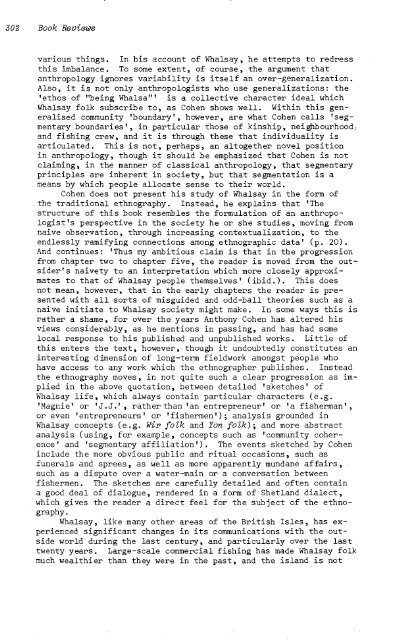CONTENTS NO.I - Institute of Social and Cultural Anthropology ...
CONTENTS NO.I - Institute of Social and Cultural Anthropology ...
CONTENTS NO.I - Institute of Social and Cultural Anthropology ...
Create successful ePaper yourself
Turn your PDF publications into a flip-book with our unique Google optimized e-Paper software.
302 Book Revie~8<br />
various things. In his account <strong>of</strong> Whalsay, he attempts to redress<br />
this imbalance. To some extent, <strong>of</strong> course, the argument that<br />
anthropology ignores variability is itself an over-generalization.<br />
Also, it is not only anthropologists who use generalizations: the<br />
'ethos <strong>of</strong> ffbeing Whalsa"' is a collective character ideal which<br />
Whalsay folk subscribe to, as Cohen shows well. Within this generalised<br />
community 'boundary', however, are what Cohen calls 'segmentary<br />
boundaries', in particular those <strong>of</strong> kinship, neighbourhood:<br />
<strong>and</strong> fishing crew, <strong>and</strong> it is through these that individuality is<br />
articulated. This is not, perhaps, an altogether novel position<br />
in anthropology, though it should be emphasized that Cohen is not<br />
claiming, in the manner <strong>of</strong> classical anthropology, that segmentary<br />
principles are inherent in society, but that segmentation is a<br />
means by which people allocate sense to their world.<br />
Cohen does not present his study <strong>of</strong> Whalsay in the form <strong>of</strong><br />
the traditional ethnography. Instead, he explains that 'The<br />
structure <strong>of</strong> this bo.ok resembles the formulation <strong>of</strong> an anthropo-<br />
's perspective in the society he or she studies, moving from<br />
observation, through increasing contextualization, to the<br />
ramifying connections among ethnographic data' (p. 20).<br />
And continues: 'Thus my ambitious claim is that in the progression<br />
from chapter two to chapter five, the reader is moved from the outsider's<br />
naivety to an interpretation which more approximates<br />
to that <strong>of</strong> Whalsay people themselves' (ibid.). This does<br />
not mean, however, that in the early chapters the reader is presented<br />
with all sorts <strong>of</strong> misguided <strong>and</strong> odd-ball theories such as a<br />
naive initiate to Whalsay society might make. In some ways this is<br />
rather a shame, for over the years Anthony Cohen has altered his<br />
views considerably, as he mentions in passing, <strong>and</strong> has had some<br />
local response to his published <strong>and</strong> unpublished works. Little <strong>of</strong><br />
this enters the text, however, though it undoubtedly constitutes an<br />
dimension <strong>of</strong> long-term fieldwork amongst people who<br />
have access to any work which the ethnographer publishes. Instead<br />
the ethnography moves, in not quite such a clear progression as implied<br />
in the above quotation, between detailed 'sketches' <strong>of</strong><br />
Whalsay life, which always contain particular characters (e.g.<br />
'Magnie' or 'J.J.', rather than 'an entrepreneur' or 'a fisherman',<br />
or even<br />
' or 'fishermen'); analysis grounded in<br />
Whalsay concepts (e.g. Wir folk <strong>and</strong> Yan folk); <strong>and</strong> more abstract<br />
analysis (using, for example, concepts such as 'community coherence'<br />
<strong>and</strong> 'segmentary affiliation'). The events sketched by Cohen<br />
include the more obvious public <strong>and</strong> ritual occasions, such as<br />
funerals <strong>and</strong> sprees, as well as more apparently mundane affairs,<br />
such as a over a water-main or a conversation between<br />
fishermen. The sketches are carefully detailed <strong>and</strong> <strong>of</strong>ten contain<br />
a good deal <strong>of</strong> , rendered in a form <strong>of</strong> Shetl<strong>and</strong> dialect,<br />
which gives the reader a direct feel for the subject <strong>of</strong> the ethnography.<br />
Whalsay, like many other areas <strong>of</strong> the British Isles, has experienced<br />
significant in its communications with the outside<br />
world during the last century, <strong>and</strong> particularly over the last<br />
twenty years.<br />
commercial fishing has made Whalsay folk<br />
much wealthier than they were in the past, <strong>and</strong> the isl<strong>and</strong> is not

















